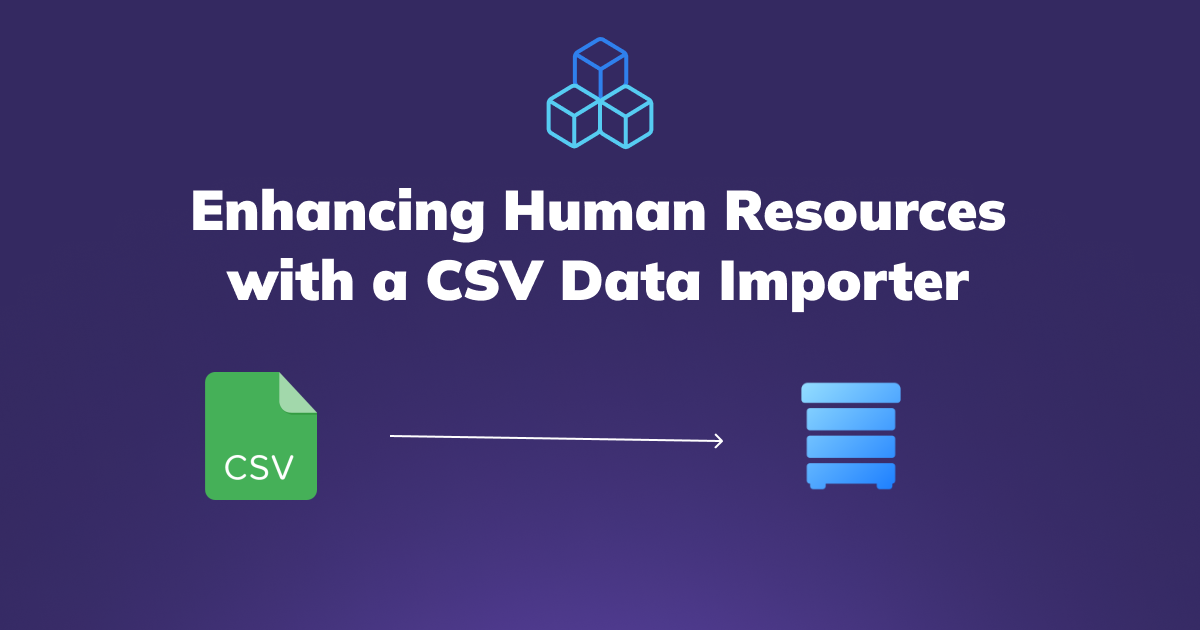Enhancing Human Resources with an Embeddable CSV Data Importer

In today’s data-driven world, the role of Human Resources (HR) has evolved into a strategic powerhouse fueled by analytics and insights. Accurate data collection, management, and analytics are essential for effective HR operations.
Among the many tools available, an embeddable CSV data importer stands out as a crucial asset, seamlessly integrating data from various sources into HR systems.
This blog post will delve into the myriad of uses and benefits of an embeddable CSV data importer in Human Resources, providing you with the insights needed to leverage this tool to its fullest potential.
Introduction to Embeddable CSV Data Importers
What is an Embeddable CSV Data Importer?
At its core, an embeddable CSV data importer is a tool designed to streamline the process of importing data from CSV (Comma-Separated Values) files into a software system. It is typically embedded within a web application, enabling users to upload their CSV files directly into the system without requiring complex manual data entry or external software intervention.
Why CSV Files?
CSV files remain a preferred format for data sharing due to their simplicity, human-readability, and compatibility across numerous applications. This format is widely adopted in HR for exporting and importing employee data, attendance records, payroll information, and more.
Transforming HR Operations with CSV Data Importer
- Efficient Recruitment Process: Managing recruitment data from multiple sources, such as job boards, social media, and internal referrals, can be overwhelming. An embeddable CSV data importer simplifies the process, enabling seamless integration of applicant data into the HR system.
Streamlining Candidate Management
Centralized Candidate Database: Aggregating candidate information from various platforms into a single, integrated system provides HR professionals with a comprehensive view of all applicants, enhancing their ability to manage and evaluate candidates effectively.
Enhanced Applicant Tracking: Tracking applicant progress through different stages of the recruitment pipeline becomes easier with consolidated data. HR teams can quickly identify bottlenecks and make data-informed decisions to expedite the hiring process.
- Employee Onboarding: A smooth onboarding process is crucial for new employees to feel welcomed and prepared. An embeddable CSV data importer ensures that all necessary employee details are imported accurately and efficiently.
Creating a Seamless Onboarding Experience
Automated Data Entry: Instead of manually entering new hire information into various systems, HR teams can use the importer to automatically populate employee details across multiple platforms, including payroll, benefits, and training systems.
Timely and Accurate Information: Ensuring that employee data is accurate and up-to-date from the onset reduces the risk of errors and omissions, thereby enhancing the onboarding experience for new hires.
- Simplified Payroll Management: Accurate payroll processing is fundamental to employee satisfaction and compliance with legal standards. An embeddable CSV data importer streamlines payroll management by integrating payroll data from various sources.
Optimizing Payroll Processes
Integration with Payroll Systems: By importing payroll data directly into payroll software, HR departments can ensure accurate and timely processing of salaries, bonuses, and deductions.
Compliance and Reporting: Ensuring compliance with tax regulations and generating detailed payroll reports becomes easier with integrated data, reducing the administrative burden on HR teams.
- Comprehensive Compensation Management: Managing compensation data can be complex, especially in organizations with diverse compensation structures. An embeddable CSV data importer aids in consolidating and analyzing compensation data from various sources.
Enhancing Compensation Strategies
Data-Driven Decisions: By integrating compensation data from multiple systems, HR can analyze trends and make informed decisions about salary adjustments, bonuses, and other compensation-related matters.
Employee Equity: Ensuring equitable compensation across the organization is easier when all compensation data is centrally accessible and analyzable.
- Training and Development: Continuous employee training and development are crucial for maintaining a competitive edge. An embeddable CSV data importer facilitates the integration of training data, enhancing the ability to track and manage employee development.
Managing Training Programs
Comprehensive Training Records: Consolidating data from various training programs into a unified system provides a complete view of employee development activities, enabling HR to tailor training programs to individual needs.
Performance Tracking: Assessing the impact of training programs on employee performance becomes more straightforward with integrated data, helping HR to identify successful strategies and areas for improvement.
- Performance Management: Effective performance management processes require accurate data for setting goals, evaluating performance, and providing feedback. A CSV data importer simplifies the aggregation of performance data.
Streamlining Performance Evaluations
Integrated Performance Data: By importing performance metrics and evaluations from various sources into a unified system, HR can provide a holistic view of employee performance.
Data-Driven Feedback: Offering specific, data-driven feedback becomes easier with consolidated performance data, enhancing the effectiveness of performance reviews and goal setting.
- Employee Engagement and Retention: Understanding and enhancing employee engagement is key to retaining top talent. An embeddable CSV data importer aids in collecting and analyzing engagement data from multiple sources.
Enhancing Employee Satisfaction
Centralized Engagement Data: Aggregating data from employee surveys, feedback forms, and other engagement tools into a unified system provides insights into employee satisfaction and areas needing improvement.
Proactive Retention Strategies: Analyzing engagement data helps HR identify potential retention issues and implement proactive strategies to maintain a motivated and committed workforce.
Technical Considerations for Implementing a CSV Data Importer
- Ease of Integration: Choosing an embeddable CSV data importer that integrates seamlessly with existing HR systems and platforms is crucial. This ensures a smooth implementation process and minimizes disruptions to ongoing HR operations.
- Data Security: Given the sensitive nature of HR data, ensuring the security of the imported data is paramount. The importer should comply with data protection regulations and incorporate robust security measures to safeguard against data breaches.
- User-Friendly Interface: A user-friendly interface ensures that HR professionals can easily navigate and utilize the importer without extensive training. Intuitive navigation and clear instructions enhance the overall user experience.
- Customization Options: Different organizations have unique data requirements. An ideal CSV data importer should offer customization options to cater to specific organizational needs, allowing HR teams to tailor data import processes accordingly.
- Scalability: As organizations grow, their data requirements evolve. The chosen CSV data importer should be scalable, and capable of handling increasing volumes of data without compromising performance.
Real-World Case Studies
Case Study 1: Accelerating Recruitment at a Tech Startup
A tech startup faced challenges in managing recruitment data from multiple sources. The implementation of an embeddable CSV data importer allowed the HR team to consolidate candidate information from job boards, referral systems, and social media platforms into a single database. This streamlined candidate management led to a 30% reduction in time-to-hire and a more efficient recruitment process.
Case Study 2: Enhancing Employee Onboarding at a Manufacturing Firm
A large manufacturing firm struggled with the manual entry of new hire information into various systems during onboarding. By deploying an embeddable CSV data importer, the firm automated the data entry process, ensuring that new employee details were accurately populated across payroll, benefits, and training systems. This resulted in a smoother onboarding experience and a 25% improvement in new hire productivity.
Case Study 3: Optimizing Payroll Management at a Financial Institution
A financial institution faced issues with payroll accuracy due to data inconsistencies from multiple sources. The introduction of an embeddable CSV data importer enabled the HR team to integrate payroll data seamlessly, reducing errors and ensuring timely salary processing. Compliance and reporting processes were also enhanced, leading to a 20% reduction in payroll-related discrepancies.
Conclusion
The integration of an embeddable CSV data importer into Human Resources operations offers numerous benefits, from streamlining recruitment and onboarding processes to enhancing payroll management and employee engagement. By centralizing data from various sources, HR teams can make data-driven decisions, reduce administrative burdens, and enhance overall efficiency.
Implementing a CSV data importer requires careful consideration of factors such as ease of integration, data security, user-friendliness, customization options, and scalability. The real-world case studies highlighted in this post demonstrate the tangible impact of this tool in diverse organizational contexts, underscoring its significance in modern HR management.
In conclusion, leveraging an embeddable CSV data importer empowers HR professionals to harness the full potential of their data, transforming HR operations into a strategic enabler of organizational success. Embrace this technology to stay ahead in the ever-evolving landscape of Human Resources and drive your organization towards greater efficiency and effectiveness.

